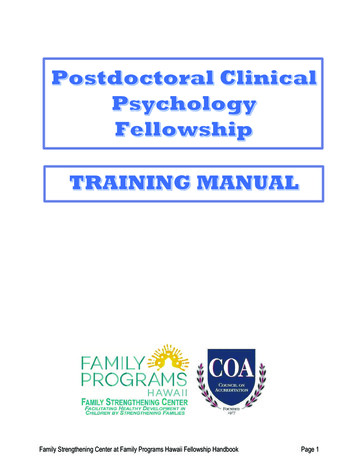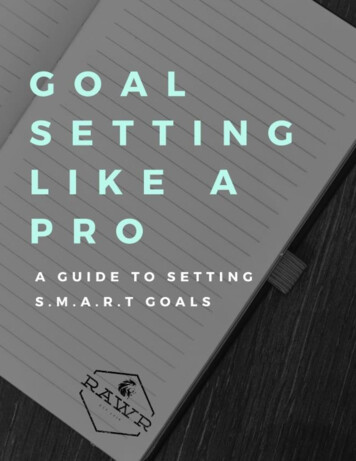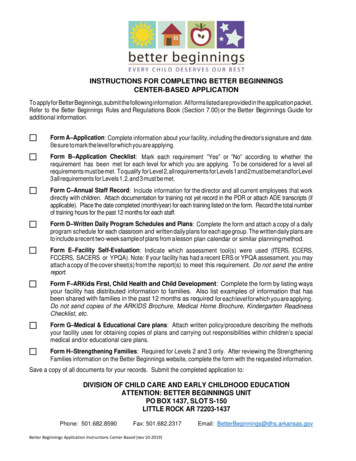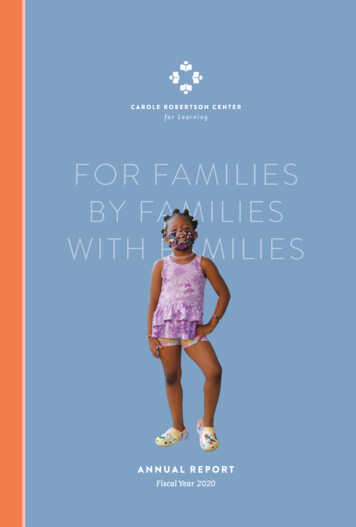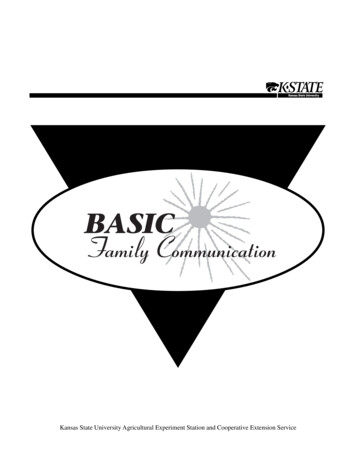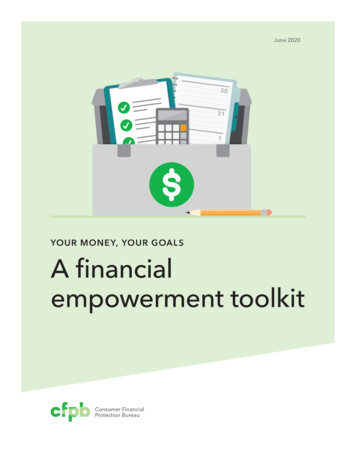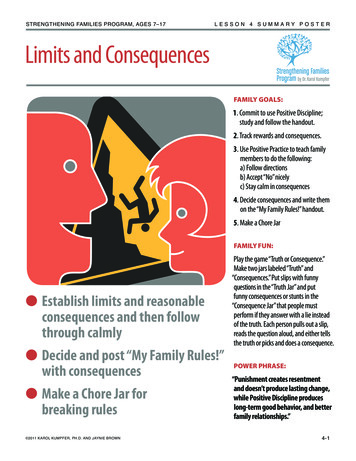
Transcription
STRENGTHENING FAMILIES PROGRAM, AGES 7–17LESSON 4 SUMMARY POSTERLimits and ConsequencesFAMILY GOALS:1. Commit to use Positive Discipline;study and follow the handout.2. Track rewards and consequences.3. Use Positive Practice to teach familymembers to do the following:a) Follow directionsb) Accept “No” nicelyc) Stay calm in consequences4. Decide consequences and write themon the “My Family Rules!” handout.5. Make a Chore JarFAMILY FUN:l Establish limits and reasonableconsequences and then followthrough calmlyl Decide and post “My Family Rules!”with consequencesl Make a Chore Jar forbreaking rules 2011 KAROL KUMPFER, PH.D. AND JAYNIE BROWNPlay the game “Truth or Consequence.”Make two jars labeled “Truth” and“Consequences.” Put slips with funnyquestions in the “Truth Jar” and putfunny consequences or stunts in the“Consequence Jar” that people mustperform if they answer with a lie insteadof the truth. Each person pulls out a slip,reads the question aloud, and either tellsthe truth or picks and does a consequence.POWER PHRASE:“Punishment creates resentmentand doesn’t produce lasting change,while Positive Discipline produceslong-term good behavior, and betterfamily relationships.”4-1
STRENGTHENING FAMILIES PROGRAM, AGES 7–17LESSON 4Positive DisciplineAdding mild consequences to your rewards program increases good behaviorSeven Steps of Positive DisciplinePut Positive Discipline into Practice1. Teach the behaviors you want using “Positive Practice.”(“Positive Practice” is teaching kids the specific steps of pro-social good behavior.)2. Decide on negative consequences ahead of time; discuss themwith your children. (Short, mild consequences work best.)3. Give clear directions.4. Remain calm.5. Give a Warning Cue.6. Be consistent in giving consequences every time.7. Make sure your kids know they are loved.Teach good behavior using Positive Practice1) Name the skill and say how it will benefit your child.2) Explain the steps.3) Ask questions to check for understanding so you’re sure yourchild knows what you expect.4) Help your child practice the skill using several pretend situations.5) Provide feedback and praise.Use Positive Practice to correct misbehavior:1) Show empathy for your child’s feelings. (Don’t use “but.”)2) Describe what your child did wrong. (“Just now, you.”)3) State the correct thing your child needs to do.4) Give a consequence that can be reduced if your child practiceswillingly.5) Invite your child to practice the skill —and praise their performance.Follow the rules for choosing consequences:1) Consequences need to match the severity of the misbehavior.2) Kids need to know what the consequences are beforehand.3) Consequences need to be mild and of short duration.4) Consequences need to involve a “response cost” (e.g., it coststhe kids something in time, effort, or money.)5) Consequences need to be given calmly and not in anger.6) Consequences need to be followed by expressions of love.How to give Clear Directions:1. Get your child’s attention.2. Give lead-time warning if possible.3. Tell exactly what to DO; explain what, how, and when you wantit done.4. Be brief (don’t follow with long explanation).5. Tell, don’t ask.6. Use a firm, but polite, voice.7. Follow through. (“Follow through” means stand near your child;give one Warning Cue. If they don’t obey after the Warning Cue,give consequence.)Directions that DON’T work:a) Chain directions b) Vague directions c) Question directionsd) “Let’s.” directions e) Directions followed by a long explanationTeach Behaviors You WantUse “Positive Practice” behavior.Give Clear Direction“Please.”Wait 10 SecondsFollows DirectionIgnores DirectionComplimentWarning Cue“You need to ” or“Remember the rule.”Wait 10 SecondsIgnores Direction(or says he or she will and doesn’t)Follows DirectionComplimentGive negativeconsequenceExpress Love 2011 KAROL KUMPFER, PH.D. AND JAYNIE BROWN4-2
STRENGTHENING FAMILIES PROGRAM, AGES 7–17LESSON 4Choosing Effective Negative ConsequencesReplacing punishment with consequences that workA negative consequence is effective when it helps bring about long-term positive change in a child’s behavior, while still preserving a loving parent/childrelationship. The difference between punishment and positive discipline is intent: the intent of punishment is to inflict pain; the intent of positive disciplineis to train a child in positive, pro-social behaviors. Punishment is ineffective because it does not bring about long-term change (i.e. you can’t punishpeople into lasting good behavior), and it harms relationships so children don’t want to please you. Choosing consequences ahead of time enables you tobe fair (kids know what to expect), fit the consequence size to the misbehavior, and teach missing skills to help your child improve long-term behavior.Consequences should include a”response cost”—the time, effort, or money the child needs to give to “make it right.”EXAMPLES OF EFFECTIVE CONSEQUENCES Positive Practice (practice the missing social skill that led to Make it right (apologize and fix the mistake)the misbehavior) Grounding from privileges or possessions for a short time (6–24 hours) Extra chores (choose a chore from the Chore Jar)until the child does Positive Practice or makes it right Time out (effective for kids ages 2–12)EFFECTIVE NEGATIVE CONSEQUENCES ARE:DRAWBACKS TO PUNISHMENT INCLUDE:1. Mild: Doesn’t cause physical or emotional harm2. Kind: Doesn’t involve anger, yelling, humiliation, or threats3. Logical: Results logically from the misbehavior4. Instructive: Involves practicing the missing skill5. Understood: Agreed upon beforehand6. Simple to give and track (ex. “Chore Jar” and “Tracking Sheet”)7. Consistent: Negative behavior results in negative consequence8. Loving: Followed by a sincere expression of love9. Safe: Never violates a child’s basic human rights to food, shelter,emotional and physical safety, love, or education1. Fear and resentment: Kids won’t like or respect you,making it hard for them to obey you or accept your values2. Two-faced behavior: Kids only behave when you’re around3. Imitation: Children hurt others (including you when they’re grown)4. Low self-esteem: Children think parents don’t love them5. Hard to control: Kids build up tolerance to pain;parents escalate and become abusive6. Ineffective: Usually fails to produce lasting change7. I nsecure attachment: Failure to bond with parents;negatively affects future relationships8. Harsh physical consequences lowers a child’s IQPRE-PLANNED NEGATIVE CONSEQUENCESAs a family, discuss negative behaviors and decide on negative consequences ahead of time. Write them in the spaces below.Minor OffensesMedium OffensesMajor orBehaviorConsequenceConsequenceConsequence 2011 KAROL KUMPFER, PH.D. AND JAYNIE BROWN4-3
STRENGTHENING FAMILIES PROGRAM, AGES 7–17LESSON 4Chore JarEncourage good behavior through constructive consequencesThe best way of changing behavior is to reward kids for doing a misbehavior’s“Positive Opposite.” But sometimes they also need a mild, easy to administernegative consequence. A Chore Jar with slips listing extra chores (that arenot a child’s normal jobs) makes this easy. (Slips can also be color-coded fordifficulty.) When kids misbehave, they have to randomly pull out a slip anddo the chore before they play. Keep track of the slips on the “Calm Consequences” tracking sheet. Extra Chores provide a “Response Cost,” teach kidsuseful skills, and keep the house cleaner. It’s a win-win for everyone.CHORESWork to Clean Up Your Act 2011 KAROL KUMPFER, PH.D. AND JAYNIE BROWNFamily Fun: Have your kidsdecorate a Chore Jar. The followingitems can be helpful: Colored paper, cloth, or paint Family photos Pictures cut out from magazinesEXAMPLES OF EXTRA CHORES: Shake rugs; sweep stairs, front or back porch,remove cobwebs in each room; dust picture frames; clean window(s);dust shelves; wipe baseboards with damp rag; clean handprints off doors,doorjambs, and light-fixtures; scrub the shower or bathtub grout withtoothbrush; wash, dry, fold and put away an extra load of laundry; scrubthe fronts of kitchen or bathroom cupboards; scrub fronts of dishwasher,oven, or fridge; sanitize kitchen counters with anti-bacterial wipes; cleanmicrowave inside and out; sweep under the kitchen table; clean and polishall the mirrors; empty all the trash; dust lamp shades, clean a toilet, vacuumor sweep one or more rooms.4-4
STRENGTHENING FAMILIES PROGRAM, AGES 7–17LESSON 4Calm Consequences Reduce ConflictTracking Sheet—AdultStaying calm when children misbehave is possible when you develop the right attitudes and skills. Here are some ideas to help:Attitude #1: “I want to be a personal trainer for my child, not a punisher.”Attitude #2: “Anger makes my brain less effective, distracts my kids fromwhat I want him to learn, and harms relationships.”Attitude #3: “I can choose to not be angry.”Skill #1: “As soon as a child misbehaves, take a deep, calming breath beforesaying anything.”Skill #2: When a child misbehaves, think of it as a teaching moment, andask yourself, “What skill is my child missing in this situation?”Skill #3: Use this pattern to help you give calm consequences:1) “I understand you feel . . . “ (Express empathy.)2) “Just now you . . . “ (Say what they did wrong.)3) “What you need to do is . . . “ (Tell the skill they should haveused instead.”4) “For choosing to . . ., you have earned a negative consequenceof . . . “5) “If you want to practice the skill of . . . right now, we will reducethe negative consequence to . . . “DateChildMisbehaviorConsequence 2011 KAROL KUMPFER, PH.D. AND JAYNIE BROWNGivenCalmlyReceivedCalmly4-5
STRENGTHENING FAMILIES PROGRAM, AGES 7–17LESSON 4I Stayed Calm!Tracking Sheet—TeenWhen you make mistakes, like disobeying family rules or harming yourself, others, or things (including animals), you may receive a negative consequence.The negative consequence helps you know when you made a wrong choice, and you know you need to change your behavior to have a happy, successful life.If your parent gives you the negative consequence kindly and calmly, then it can help you be a better person. If you can learn to stay calm when you get anegative consequence, it shows you are developing more self-control—and you will receive fewer negative consequences.Staying calm when children misbehave is possible when you develop the right attitudes and skills. Here are some ideas to help:Attitude #1: “Staying calm keeps the consequence from getting worse.”Attitude #2: “Admitting and accepting responsibility for my mistakes is thefair and mature thing to do.”Skill #1: When you get in trouble, take a deep breath through your nose.Skill #2: When you realize you made a mistake, apologize.Instructions: Write down the answer to these questions for each negative consequence you receive this week:a) What did YOU DO to receive a negative consequence?b) What was the CONSEQUENCE?c) Did your parent stay calm while giving the negative consequence to you?d) Did you stay calm while receiving the negative consequence?a) Mistake I Madeb) Negative Consequencec) Was My Parent Calm?d) Did I Stay Calm?a) Mistake I Madeb) Negative Consequencec) Was My Parent Calm?d) Did I Stay Calm?a) Mistake I Madeb) Negative Consequencec) Was My Parent Calm?d) Did I Stay Calm?a) Mistake I Madeb) Negative Consequencec) Was My Parent Calm?d) Did I Stay Calm?a) Mistake I Madeb) Negative Consequencec) Was My Parent Calm?d) Did I Stay Calm? 2011 KAROL KUMPFER, PH.D. AND JAYNIE BROWN4-6
STRENGTHENING FAMILIES PROGRAM, AGES 7–17LESSON 4I Stayed Calm!Tracking Sheet—ChildWhen you make mistakes, like disobeying family rules or harming yourself, others, or things (including animals), you may receive a negative consequence.The negative consequence helps you know when you made a wrong choice. If your parent gives you the negative consequence kindly and calmly, then it canhelp you be a better person. If you can learn to stay calm when you get a negative consequence, it shows you are developing more self-control—and you willreceive fewer negative consequences.Staying calm when children misbehave is possible when you develop the right attitudes and skills. Here are some ideas to help:Attitude #1: “Staying calm keeps the consequence from getting worse.”Attitude #2: “Admitting and accepting responsibility for my mistakes is thefair and mature thing to do.”Skill #1: When you get in trouble, take a deep breath through your nose.Skill #2: When you realize you made a mistake, apologize.Instructions: Write down the answer to these questions for each negative consequence you receive this week:a) What did YOU DO to receive a negative consequence?b) What was the CONSEQUENCE?c) Did your parent stay calm while giving the negative consequence to you?d) Did you stay calm while receiving the negative consequence?a) Mistake I Madeb) Negative Consequencec) Was My Parent Calm?d) Did I Stay Calm?a) Mistake I Madeb) Negative Consequencec) Was My Parent Calm?d) Did I Stay Calm?a) Mistake I Madeb) Negative Consequencec) Was My Parent Calm?d) Did I Stay Calm?a) Mistake I Madeb) Negative Consequencec) Was My Parent Calm?d) Did I Stay Calm?a) Mistake I Madeb) Negative Consequencec) Was My Parent Calm?d) Did I Stay Calm? 2011 KAROL KUMPFER, PH.D. AND JAYNIE BROWN4-7
STRENGTHENING FAMILIES PROGRAM, AGES 7–17LESSON 4Pro-Social Skills for a Successful LifeHow to get along with parents and everyone elseSocial skills, like these, help children function well in society and develop “emotional intelligence”—the ability to manage emotions and respond in apro-social way. Have kids memorize the steps of each skill and practice different pretend situations using them. Reward them for practicing; then trackand reward real-life performance. When kids forget to use the skills, have them do “Positive Practice.” For more social skills, see “Teaching Social Skillsto Youth” at www.boystownpress.org.HOW TODEVELOPIMPULSE CONTROL1. Practice Mindfulness Breathing for 2–5 minutes night andmorning to train your brain to focus.2. Choose one weak area in your life where you need impulsecontrol. Make a plan of what to think and do when you aretriggered to be impulsive. Then courageously follow your plan.3. When you are tempted to be impulsive, take three deep breathsthrough your nose and ask yourself the W.I.S.E. question:W Will everyone say it’s ok if I do or say it?I Is it true and necessary?S Will this help me be my highest and best self?E Do I want everyone to do it to me?4. Redirect your thoughts to a more positive thing to do; then do it.HOW TOFOLLOWINSTRUCTIONS1.2.3.4.HOW TOACCEPTNO NICELY1.2.3.4.Look at the person who is speaking to you.Calmly ask for a reason if you don’t understand.Say “okay” and thank the person for listening.If you disagree, you may calmly bring it up later. However,after two times the discussion is over. 2011 KAROL KUMPFER, PH.D. AND JAYNIE BROWNLook at the person who is speaking to you.Repeat the instructions and say okay.Do what is asked and do it the best you can.Report back when you’ve finished.HOW TOSTAY CALMIN CONSEQUENCES1.2.3.4.5.Take a deep calming breath.Look at the person with a polite face.Remind yourself to be calm.Don’t argue.Say “okay” in a neutral voice tone.4-8
STRENGTHENING FAMILIES PROGRAM, AGES 7–17LESSON 4Skills for Successful ParentingHow to handle stressful situationsThese cards contain tips that cover some common parenting challenges. Memorize the steps and use them regularly to reduce parent stress, help yourkids have better behavior, and make your job as a parent more fun and enjoyable.HOW TO DOHOW TOPOSITIVE CONFRONTNEGATIVE BEHAVIORPRACTICE1.2.3.4.Name the skill and say how it will benefit your child.Explain the steps of the skill.Ask the child to repeat the steps.Have your child practice the skill several timesusing pretend situations.5. Provide feedback and praise.HOW TOGIVE CALMCONSEQUENCES1.2.3.4.Stay calm and talk privately with your child.Express empathy: “I understand how your feel.”Describe behavior: “Just now you.” (Don’t begin with “But.”)Give the consequence: “For choosing to , you earned[consequence].”5. Reduce consequence if they do positive practice and makeamends.6. Express love. 2011 KAROL KUMPFER, PH.D. AND JAYNIE BROWN1.2.3.4.5.Find a good time to talk privately and calmly.Describe the behavior you observed.Ask what happened.Ask what the child could have done differently.Ask what the child can do to correct behavior andmake amends. Give consequence if needed.6. Ask the child to practice the correct behavior.7. Express love.HOW TOHANDLECHILD RAGES1. Stay calm. View it as a teaching opportunity.2. Recognize a child has a right to feel angry, but not the right tobehave badly.3. Say, “I understand you feel angry. We will talk about this whenwe both feel calm.”4. Walk away. Don’t attempt to reason with a raging person.5. When calm, discuss the situation; give consequences forbad behavior.6. Use up Positive Practice to teach missing skills that calm rage.4-9
STRENGTHENING FAMILIES PROGRAM, AGES 7–17LESSON 4Skills for Successful ParentingHow to correct behaviorThese cards contain tips that cover some common parenting challenges. Memorize the steps and use them regularly to reduce parent stress, help yourkids have better behavior, and make your job as a parent more fun and enjoyable.HOW TO USE7 STEPS OFPOSITIVE DISCIPLINE1. Teach the behaviors you want using “Positive Practice.”(Positive practice is teaching kids the specific steps of eachgood behavior you want them to do and helping thempractice it.)2. Decide on negative consequences ahead of time anddiscuss them with your children. Remember, short, mildconsequences work best.3. Give clear directions.4. Remain calm.5. Give a warning cue.6. Be consistent. Give the right consequence every time.7. Make sure your kids know they are loved.HOW TOGIVE CLEARDIRECTIONS1. Get your child’s attention.2. Give him or her a warning ahead of time, if possible.3. Tell him or her exactly what to do. Explain what, how, andwhen you want it done.4. Be brief (don’t follow with a long explanation).5. Use “please” and then tell, don’t ask.6. Use a firm, but polite, voice.7. Follow through to make sure he or she did what you asked.You can follow through by standing near your child and startby giving one warning cue. Wait ten seconds, and if theydon’t obey, then give the consequence.8. Here are some directions that DON’T work: chain directions,vague directions, question directions, “Let’s . . . directions,” ordirections followed by a long explanation.HOW TO USEPOSITIVE PRACTICE TO CORRECT MISBEHAVIOR1.2.3.4.Show empathy for your child’s feelings. Don’t use “but” or it negates your empathy statement.Describe what your child did wrong. Example: “Just now you . . .”State the correct thing your child needs to do. Example: “What you need to do is . . .”Give a consequence that can be reduced if your child practices the correct behavior willingly. Example: “For hitting your sister, you need to taketwo yellow slips from the chore jar. But, if you practice talking about it nicely instead of hitting, you only need to take one slip. 2011 KAROL KUMPFER, PH.D. AND JAYNIE BROWN4-10
STRENGTHENING FAMILIES PROGRAM, AGES 7–17LESSON 4Track and Reward Positive PracticeBrain Gain ChartWhen we improve our behavior by learning and practicing a new skill, we wire our brain to be more effective. Decide how often to give a reward bycircling with a colored pen or pencil certain dots, such as every third or fourth dot. Have your child draw a line between the dots as he or sheaccomplishes what is expected.What seems like the end.3736303435.is only the beginning ofsomething 1312119786REWARD:What I will do to earn the reward:5342All progress starts 2011 KAROL KUMPFER, PH.D. AND JAYNIE BROWN1with the first step4-11
STRENGTHENING FAMILIES PROGRAM, AGES 7–17LESSON 4Track and Reward Positive PracticeHigh-5sPut a small sticker or mark each time a skill or behavior is practiced. Skills could include staying calm, obeying the first time, accepting “No” nicely, etc.An alternative to using stickers is using a rating system. For example, you can rate the performance from 1-5, 5 being excellent and 1 the least acceptable.Write the score on the poster each day. At the end of the week add up the score. Pick a minimum score, such as 25 or 28 that earns the reward. Give a bonusfor extra high EDTHUFRISATSKILL:SUNMONTUEWEDTHUFRISAT 2011 KAROL KUMPFER, PH.D. AND JAYNIE BROWN4-12
STRENGTHENING FAMILIES PROGRAM, AGES 7–17LESSON 4Track and Reward Positive PracticeBee Good ChartWrite the skill or behavior to be practiced at the bottom of the beehive. Place a small sticker or mark on the poster each time that the skill or behavior ispracticed. Behaviors could be making the bed, obeying the first time, accepting “No” nicely, putting clothes away, etc.Bees are known for their hard work and their positive effect on their own family or hive. A hive is like a home—everyone has a job to do to make the familyrun happily and well. If everyone does their part, pure sweet honey is the reward.Better beehavior beegins with me.SUNMONTUESWEDTHUFRISATGOOD BEHAVIORSGOOD BEHAVIORSGOOD BEHAVIORSB E H A V I O R S 2011 KAROL KUMPFER, PH.D. AND JAYNIE BROWN4-13
Low self-esteem: Children think parents don’t love them 5. Hard to control: Kids build up tolerance to pain; parents escalate and become abusive 6. Ineffective: Usually fails to produce lasting change 7. Insecure attachment: Failure to bond with parents; negatively affects future relatio
